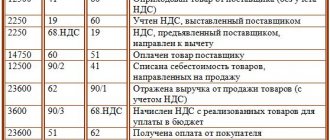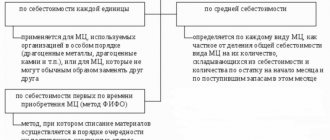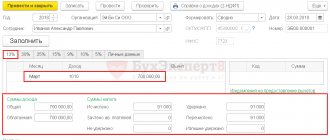In the “accounting entries” section you will find a detailed description of all business transactions based on specific examples for 2019. Each article contains a theoretical part (laws) and a practical part (examples of postings).
Most of the material contains instructions for reflecting these transactions in the 1C 8.3 (Accounting) program.
You can start learning how to create entries and enter accounting transactions in the article Accounting Entries for Beginners.
See also the tutorial on 1C Accounting 8.3:
Goods
Every enterprise that conducts business activities has commodity-material assets. Below is a list of most accounting entries for goods:
- Accounting for goods in accounting: postings, examples, laws
- Revaluation of goods in accounting entries
- Movement of goods through warehouses: postings, rules, examples
- Resale of goods between the commission agent and the principal in accounting
- Reflection of goods in storage in accounting entries
- Accounting entries for the transfer of goods free of charge
- Accounting accounts and entries for payment for goods and services
- Accounting for goods in transit
- Consignment goods: the relationship between the consignor and the commission agent
- Carrying out an inventory: receipt of surpluses and write-off of shortages
- How goods are shipped in accounting entries using an example
- Postings for the purchase of goods and services
- Postings for the sale of goods and services
- Returning goods to the supplier: reasons, posting tables, examples
- Postings for receipt of goods to the warehouse
- How to reflect the return of goods from a buyer in accounting
- Write-off of goods in case of shortage or damage in accounting entries
- Postings according to additional costs for delivery of goods
Documentary confirmation
The provision of services is documented. It is recorded in the following accounting forms:
- agreement;
- act on the work performed (with signatures, seals, and other details of the contractor and the customer);
- invoice.
Postings for such transactions depend on the type of service. These include:
- transport;
- rental and storage;
- informational;
- communications;
- housing and communal services;
- KMM maintenance;
- medical;
- working with clients;
- educational and others.
Direct material costs do not include information, legal, auditing and other similar services. Accounting for the provision of services in this case is carried out as follows:
- — DT 90.2 KT 20
In the case of material costs, payments are calculated on the credit of accounts 20, 26, 43. In this case, calculations are carried out taking into account VAT in the amount of 18% of the final cost. To reduce the tax burden on an organization, the following taxation systems should be used: OSNO, UTII, simplified tax system.
Accounting for services provided is carried out only after the actual completion of the work. Income and expenses are taken into account in the process of acceptance of completed work by the customer. Upon completion of the work, a corresponding act is drawn up, which is confirmed by signatures, seals, and other details of the parties. This act is the main supporting document. It can be replaced by an invoice, a copy of the waybill, and various reports.
Materials
- Postings by materials (account 10)
- Stationery in accounting - postings, accounting accounts, examples
- Postings for returnable packaging
- Accounting entries for workwear
- Transport and procurement costs in accounting
- Postings for reflecting excess materials. postings
- Postings for the return of materials
- Inventory of materials: accounting entries
- Accounting entries for transactions with customer-supplied raw materials
- Typical postings for material shortages
- Purchasing materials from a supplier - accounting entries
- Posting sales of materials on prepayment and after payment
- Postings: receipt of materials to the warehouse
- Online accounting entries for writing off materials for production, damage, sale
Accounting for intra-farm settlements
When transferring property, costs or obligations, their value is shown as a debit to account 79, and when receiving – as a credit.
For example:
| Operations | D/t | K/t |
| The parent organization transfers to the branch: | ||
| OS with accrued wear and tear | 79 02 | 01 79 |
| Inventory | 79 | 10, 41 |
| Financing to current account | 79 | 51 |
| Expenses | 79 | 20, 23, 25, 26, 29 |
| Liabilities | 79 | 60, 76 |
| The branch receives from the parent organization: | ||
| OS | 01 79 | 79 02 |
| Inventory | 10,41 | 79 |
| Cash | 51 | 79 |
| Expenses | 20, 23, 25, 26, 29 | 79 |
| Liabilities | 60, 76 | 79 |
The transfer of costs from one company structure to another is formalized using approved forms of internal documents - advice notes. Internal operations are carried out not only between the central and subordinate structures, but also through the interaction of separate units with each other.
On the account 79, the state of internal settlements is taken into account, and the transactions are displayed in mirror images, mutually excluding each other, and therefore, in the general balance sheet of the company there are no changes associated with water chemistry - assets and liabilities are listed on the same accounts, only according to analytics they relate to different branches. Thus, when forming a consolidated balance sheet for the company, the account. 79 must be reset to zero: the debit balance at the branch must correspond to the credit balance at the head office, and vice versa. Let's look at examples of the practical use of account 79.
Fixed assets
- Accounting entries for fixed assets
- Liquidation of fixed assets: postings, complete wear and tear
- Basic accounting entries for the sale of fixed assets
- Revaluation of fixed assets in accounting
- Postings for repair and modernization of the OS
- Accounting entries for fixed assets in budgetary organizations
- Accounting entries for revaluation of fixed assets
- Accounting entries for the acquisition of fixed assets
- Accounting entries for the transfer of fixed assets
- Typical accounting entries for write-off transactions of fixed assets
- Accounting entries for depreciation of fixed assets
- Accounting entries upon receipt of fixed assets
- Renting and leasing of fixed assets in accounting
***
In his work, an accountant must use a chart of accounts. At the same time, often, based on the version approved by the Ministry of Finance of the Russian Federation, specialists develop a working chart of accounts and consolidate it in the accounting policy. Accounting entries are generated based on the accounts. It is very important that they are correct, otherwise the data in accounting and tax reporting is likely to be distorted, and this is fraught with conflicts with regulatory authorities.
Similar articles
- How to correctly reflect revenue - with or without VAT?
- Nuances of postings debit 10 credit 10
- Nuances of wiring Dt 41 and Kt 41
- How to draw up a balance sheet for account 62?
- The double entry method in accounting means
Rental operations
- Sublease: accounting entries, examples, laws
- Calculation of rent in accounting
- Free rent in accounting
- Land lease in accounting
- Payment for an office or other non-residential premises
- Rent of offices for enterprises in accounting
- Renting a car from an individual in the accounting department
- Lease of property: postings, examples, laws
- Renting a vehicle in accounting
- Lease of municipal property in accounting
- Rental of premises in accounting
Settlements with buyers and suppliers
- Bills of exchange in accounting entries for mutual settlements
- Postings on account 60
- Postings under an agency agreement - how the principal and agent keep records
- We reflect acquiring in accounting entries
- Typical accounting entries to reflect bank commissions
- Uncollectible accounts receivable in accounting entries
- Commission agreement in accounting from the point of view of the commission agent
- Accounts receivable in accounting
- Transactions on assignment of debt between legal entities
- Basic accounting entries for account 62
- Adjustment of receipts in accounting
- Adjustment of sales in the current and previous periods in accounting
- Postings to accounts payable
- How to make accounting entries when returning funds to a buyer or supplier
- Postings under the agency agreement with the principal
- Assignment agreement - postings, examples, laws
- Commission trading from the principal's point of view: how to prepare accounting entries and legislation
- Postings for debt adjustments: offset, transfer and write-off of debt
- Postings for doubtful debts
- Accounting entries for advances from customers
- Debts of buyers and suppliers in accounting
Typical wiring and rules for their implementation
There are dozens of transactions; only a few basic types relate to accounting; fixed and cash assets, materials, costs and others are of particular importance.
There are several important points. Posting can only be carried out if a source document is available. When receiving a document via the Internet, confirmation with an electronic signature or sending the original in the future is required.
The correct definition of the account type and the correct coding are required. There is a certain difference between the cash register and the current account, which leads to an incorrect result at the end of the period.
There are no descriptions in accounting, and the entry is a completely incomprehensible set of symbols for an outsider. Often, many reference books are used to check the accuracy of the entries made, but the best programs to help ease the work of an accountant are programs such as 1C, the remote versions of which are very easy to use.
Salary and other benefits
- Employee benefits - how to calculate and typical transactions
- Writs of execution: accrual, payments, postings
- Postings on vacations
- Postings for accrual and payment of financial assistance to an employee
- Employee travel expenses in accounting
- Postings for gifts to employees
- Reflection of payment and accrual of bonuses in accounting
- Accounting entries for payroll
- Accrual and payment of vacation using an example
- Compensation for unused vacation - how to calculate and reflect?
- Payment of vacation pay to an employee
- Vacation reserves - examples of accounting entries
- Sick leave from an accounting perspective
- Financial assistance to an employee
- Maternity leave - payments and accounting entries
- Compensation for delayed wages: calculation and postings
- Alimony in accounting
- Postings for salary payments to an employee’s card
- Calculation of employee salaries in accounting
- Payroll from an accounting perspective
- Postings for PO deposition
- Return of wages according to accounting
- Deductions from wages in accounting
Credits and loans
- Loan repayment in accounting
- Payment of interest on a loan in accounting
- Loan repayment in accounting
- What are the types of loans, transactions, examples?
- Letter of credit - what is it, table of accounting entries
- What is a bill of exchange? Reflected in accounting
- Short-term and long-term loans
- Postings for loan repayment
- Reflection of deposits in accounting
- We reflect the organization's loans for its employee - preparation of accounting entries
- Factoring: examples, postings
- Calculation of interest on loans issued
- Calculation of interest on loans received
- Loans between organizations
- Obtaining a loan from an organization
- Issuing a loan to a legal entity or individual
- Typical accounting entries for loans
- Loans from the founder/posting founder
- Features of an interest-free loan between enterprises
- How are deposits reflected in accounting?
Accounting entries. Correspondence of accounts.
Many novice accountants often ask questions - what is “accounting entry” and what is “correspondence of accounts”. In this article, I want to not only give the concept of these two terms, but also explain with specific examples how they work.
Every action of a company, or, as it is called in accounting, a business transaction
, must be reflected in accounting, i.e.
it needs to be written down. Accounting accounts
are used for this . You can read what types of accounting accounts are here and here.
First, you should find out which accounts, according to the approved Chart of Accounts, are involved in a particular business transaction. For example: “ Goods from the supplier in the amount of 10,000 rubles have been received into the warehouse.”
According to the Chart of Accounts, accounts with suppliers are assigned
account 60.
To account for goods,
account 41
. We have decided on the accounts, then we analyze the principle of operation of each account. This video lesson, presented by my colleague, shows in a very accessible way all the most important things about the operation of active and passive accounts.
Subscribe to our YouTube channel!
Also, in addition to the video, you can read the article “Double entry in accounting”, where the tables schematically explain the principle of operation of accounting accounts.
Briefly speaking, on active
and
passive
2 types of movement
can occur either
an increase
in the account or
a decrease
.
Moreover, the increase
in
the active
account is recorded as
a Debit,
and
the decrease is recorded
as
a Credit.
On passive
In the account, the actions
are opposite
, i.e.
the increase
occurs on
Credit,
respectively, if there is
a decrease
, then the entry is made on
Debit.
So, we have dealt with the movements in the accounting accounts, now all that remains is to write down the transaction amount at the same time
to
the debit
of one account and
the credit
of another.
Let's use our example and do this together. We will start from the simplest. “ Goods in the amount of 10,000 have been capitalized...”
Consequently, our score has increased.
Because Account 41
is
active
ASSETS
are taken into account on it ), then the entry will be made by
Debit
.
At the same time, our debt to the supplier has increased, which, as we already know, is included in the Passive
Credit (takes into account
the sources of asset formation
and
debt
to third parties)
account 60
.
Thus, the entry accounting for this business transaction in accounting will look like this:
Dt 41 Kt 60
| Dt | CT | Sum | Operation name |
| 41 | 60 | 10 000 | Received goods from supplier |
This entry is called ACCOUNTING ENTRY
.
Interaction between accounts when generating accounting entries
It is customary to call
correspondence of accounts
, and the accounts affected in the record are
correspondent
.
Very good examples of accounting entries are given in this video.
In principle, in the process of work, business entities use standard accounting entries. Let’s say the correspondence of accounts when accounting for cash transactions will be something like this:
Cash receipts
| Dt | CT | Operation name |
| 50 | 71 | Return to the cash desk of unspent accountable amounts from an employee of the organization |
| 50 | 73 | Receipts to the cash desk from employees of the organization on account of settlements on issued loans |
| 50 | 62 | Receipt of funds from buyers and customers to the cash desk |
| 50 | 51 | Receipt of funds to the cash desk from the organization's current account |
| 50 | 75 | Contribution to the authorized capital of the organization in cash |
Accounting for the issuance of funds from the cash register
| Dt | CT | Operation name |
| 70 | 50 | Salary payment |
| 71 | 50 | Cash was issued from the cash register to an accountable person |
| 73 | 50 | Payment from the loan cash desk to an employee of the organization |
| 60 | 50 | Payment of funds to suppliers |
| 51 | 50 | Cash from the cash register is deposited into the organization's current account |
In any area of accounting there are corresponding accounts and their own standard transactions, be it accounting for fixed assets, materials, goods, etc., but the main thing for an accountant is to understand and remember the general principle
:
— When writing any business transaction, it is necessary to clearly distinguish 2 accounting objects.
— Remember the formulas of accounting objects: growth of Assets
is recorded by
Debit
, the growth
of Liabilities
is recorded by
Credit
.
— If the transaction amount is written as Debit
, then it should be reflected on
the Loan
.
To easily understand and navigate all areas of accounting and gain confidence in your knowledge, take practical training in the course “Accounting and Taxation for Beginners +1C8.3. Its exclusivity lies in the simultaneous combination of theory and practice, i.e., classes are held on the basis of a cross-cutting problem that directly affects all areas of accounting from the beginning of activity to the balance sheet. Information is taught in simple, understandable language. You can also choose any form of training convenient for you - full-time or distance learning. Reviews of the course “Accounting and Taxation for Beginners +1С8.3
Matasova Tatyana Valerievna expert on tax and accounting issues
Subscribe to our YouTube channel!
Calculation and payment of taxes
- Postings for accrual and payment of taxes
- Postings for accrual and payment to extra-budgetary funds
- We accept tax reduction according to the simplified tax system
- Accounting entries for state duties
- UST: postings, who pays and how much
- Basic VAT transactions
- Accounting entries for VAT calculation
- Tariffs and postings for insurance premiums
- Personal income tax: how and who pays, postings
- Paying taxes - how to reflect them in accounting entries
- Postings for land tax in accounting
- SHE and IT: what is it about?
- Transport tax and its components
- Features of income tax: who pays for what, postings
- Enterprise property tax: calculation and postings
- VAT postings when working with exports
- Tax penalties - postings, examples
- Tax loss postings
- Reflection of the minimum tax in transactions
- VAT deductible: transactions, conditions
- Accounting entries for overpayment of tax and its refund
- Postings for VAT on sales
- Postings for writing off VAT
- What is UTII: calculation, postings, legislation, examples
- VAT on advances: postings, examples, law
- Accounting entries for VAT payment
- Taxes according to the simplified tax system: features, postings, regulations, reporting
- Postings for VAT refund from the budget
- Accounting entries for VAT restoration
On-farm calculations: postings
Example 1: Transfer of assets to a division
A trading company specializing in the sale of textile products opens a branch and transfers assets to it:
- a consignment of goods worth 300,000 rubles;
- warehouse space with a book value of RUB 200,000. with accrued depreciation RUB 56,000.
Operations D/t K/t Sum In TC LLC "Len": Goods transferred 79/1 41 300 000 Transfer of premises reflected 79/1 01 200 000 The amount of depreciation taken into account 02 79/1 56 000 At the branch: The premises have been registered 01 79/1 200 000 Accrued depreciation taken into account 79/1 02 56 000 Goods received 41 79/1 300 000
Example 2: settlements for mutual repayment of obligations
The Len LLC branch purchased a batch of goods from a third party in the amount of 600,000 rubles. The Len LLC branch does not have enough own funds and with a request to make payment with a guarantee of subsequent debt coverage, the branch turned to the head office of Len LLC.
Len LLC settled with Mir LLC by paying 600,000 rubles. To repay the debt, the Len LLC branch paid an invoice for the supply of goods for the head office of Len LLC in the amount of 200,000 rubles. supplier company Atlas LLC. Subsequently, the remaining debt to the head office in the amount of 400,000 rubles. the branch repaid by transfer from the current account. How will intra-economic calculations – postings – be reflected:
Operations D/t K/t Sum At the Len LLC branch: Repayment of debt to Mir LLC is reflected 60 79/1 600 000 Payment was made to Atlas LLC for the debt to the head office 79/1 51 200 000 The debt to the head office was repaid 79/1 51 400 000 At the head office of Len LLC: Payment of delivery invoice for the branch 79/1 51 600 000 Repayment of debt to Atlas LLC is reflected 60 79/1 200 000 Funds have been received into the current account from the branch 51 79/1 400 000
Production
- Basic accounting entries for production
- Accounting entries for overhead costs
- Accounting entries for production waste
- Cost accounting using the direct costing method: postings, examples, nuances
- Accounting entries for sales of finished products
- Accounting for finished products: postings, examples, nuances
- Postings to the cost of production in accounting
- Accounting entries for main production
- Accounting entries for auxiliary production
- Accounting for production costs in transactions
- Postings for manufacturing defects
- Accounting entries in work in progress
The procedure for determining accounting entries based on facts of economic life
To master the material presented in this article, it is advisable to read the articles “Where to start studying accounting” and “Classification of accounting accounts and the procedure for their formation”
A fact of economic life can be considered an elementary unit, from a certain totality and sequence of which economic processes are formed. All facts of economic life (business transactions) that occur at the enterprise are subject to accounting after their documentation. It should be borne in mind that business transactions are recorded in chronological order and without omissions.
To account for each business transaction, it is necessary to determine the correspondence of accounts (accounting entry), after which it can be subject to subsequent accounting processing. To determine the accounting entry for a business transaction, it is necessary to indicate which accounting account is debited and which is credited. Thus, when registering a fact of economic life in the journal of business transactions, we must indicate opposite its monetary value certain accounts in debit and credit.
Correctly determining accounting entries for business transactions is one of the basic skills and abilities of any accountant. Despite the fact that accounting programs are now widespread, which independently determine accounting entries after filling out the corresponding document, the accountant must monitor the correctness of its preparation. You cannot consider yourself an accountant if you do not know how to determine accounting entries based on the facts of business life.
In order to independently learn how to correctly determine accounting entries, you need to know:
current Chart of Accounts for accounting financial and economic activities of organizations; (Link to download the Chart of Accounts indicating active, passive and active-passive accounts)
classification by composition and functional role, as well as by sources and intended purpose;
the procedure for creating active and passive accounts;
algorithm for determining accounting entries based on facts of economic life.
At the initial stage of studying accounting, it is not at all necessary to memorize the Chart of Accounts; you can print it out on your computer and look at it as needed. But I strongly recommend that you remember the remaining points. Knowing the classification by composition and by sources will allow you to independently determine which accounting account is active, passive or active-passive. Without knowledge of the procedure for generating accounts, it will be impossible to correctly determine accounting entries.
In the algorithm below for determining accounting entries, it is very important to adhere to the sequence of actions presented.
Algorithm for determining the correspondence of accounts (accounting entries) based on facts of economic life (business transactions)
1) Based on the meaning of the fact of economic life, we determine two interconnected accounts in accordance with the current Chart of Accounts, approved by order of the Ministry of Finance of the Russian Federation No. 94n dated October 31, 2000.
2) We determine which of the accounts is active, passive or active-passive in accordance with the Classification by composition and by sources
3) We take as a basis either a uniquely active account or a uniquely passive account
4) Based on the essence of the fact of economic life, we determine how it will affect the change in the account taken as a basis (increase it or decrease it). In accordance with the procedure for generating an account, we set the account taken as a basis either in debit or credit.
5) We put the second score in the opposite direction.
6) If both accounts are active-passive, then the correspondence of the accounts is determined in accordance with the current regulatory documents on accounting (Instructions for the use of the Chart of Accounts, Accounting Regulations, etc.)
Based on the previously given classification of accounts into active, passive and active-passive, we can assume that the following combinations are possible when taking into account the facts of economic life:
1) active and active, for example, transfer of materials to the main production (Debit (Dt) 20 and Credit (Ct) 10);
2) passive and passive, for example, by decision of the founders, the authorized capital is increased at the expense of additional capital (Dt 83 and Kt 80);
3) active and passive, for example, a short-term loan previously approved by the bank is transferred to the current account (Dt 51 and Kt 66);
4) active and active-passive, for example, an unused advance was returned to the cash desk by an accountable person (Dt 50 and Kt 71);
5) passive and active-passive, for example, the authorized capital has been formed in accordance with the constituent documents (Dt 75 and Kt 80);
6) active-passive and active-passive, for example, revenue from the sale of products to customers is taken into account (Dt 62 and Kt 90).
As you can guess from the examples given, cases when two active-passive accounts are used to determine an accounting entry do not occur often. Therefore, in such situations, you should use the Instructions for using the Chart of Accounts, remember the approach outlined in it regarding the active-passive account and apply it in the future.
Other accounting entries
- Budget accounting entries with examples of basic transactions
- Postings for subsidies
- Transactions in retail trade
- Accounting entries of a government institution
- Accounting entries for funds in the current (bank) account
- Postings for insurance premiums
- Accounting entries of a non-profit organization (NPO)
- Donations from an Accounting Perspective - Entries and Laws
- Adjustment entries
- Postings on membership fees to SROs and other organizations
- Postings for contributions to the authorized capital: to the current account, in the form of fixed assets and intangible assets
- Dividends - accrual and payment in accounting
- Postings on employee expense reports
What are accounting entries
At any given moment, if we consider transaction histories, there are countless payments being made by ordinary people and businesses. At the same time, any company makes sure that it has funds so as not to become bankrupt. Accounting entries help control expenses best.
Accounting entries are the same accounts that can be seen, for example, in a bank.
They are a tool for recording income and expenses. Their task is to reflect the cost of operations carried out by the company.
Organizations generally conduct accounting using a method called “double entry.” The exception is municipal and credit organizations (instructions in the order of the Ministry of Finance of Russia dated October 31, 2000 No. 94n.).
“Double entry is a demonstration of households.
transactions using two accounts, each of which has its own number, characteristics and structure, but a total amount.” Accountant Svetlana Averina
Example
.
Cash is deposited into the bank from the cash desk of a small company. Amount – 20 thousand rubles. Then the cashier must select two accounts - the 50th “Cash Office” (Ct) and the 51st “Cash Accounts” (Dt). Money is transferred from the 50th account to the 51st, and the movement is recorded by four documents - the counterfoil of the announcement for cash deposits, a bank statement, cash register account, and also an entry in the cash book: Dt 51 Kt 50 -
20,000 rubles
.
All these documents make it clear: there is more money in the bank, and less in the cash register, and the amount is the same.
Important!
In case of complications with the operation, the cashier may use three or more accounts.









